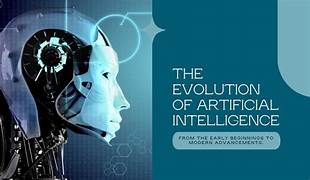The History and Evolution of Artificial Intelligence
Introduction
Artificial Intelligence (AI) has become an integral part of modern life, influencing various aspects of society, including healthcare, transportation, finance, and entertainment. But the journey of AI from an abstract concept to a transformative technology is a fascinating story of scientific curiosity, innovation, and perseverance. The evolution of AI spans centuries, starting from philosophical inquiries about the nature of human thought to today’s advanced machine learning algorithms that power autonomous systems and decision-making tools.
This article delves into the history and evolution of AI, highlighting key milestones, influential figures, and technological breakthroughs that have shaped the field.
Early Foundations: Philosophical and Mathematical Beginnings
1. Philosophical Roots
The concept of AI can be traced back to ancient history, where philosophers pondered the nature of human thought and intelligence. Greek philosopher Aristotle (384–322 BCE) introduced formal logic in his works, laying the groundwork for reasoning processes that would later influence computational thinking. Similarly, Chinese, Indian, and Islamic scholars explored theories of logic and cognition, contributing to the broader understanding of human intelligence.
In the 17th century, mathematicians like René Descartes speculated about the possibility of automating thought processes. Descartes proposed the idea of the mind as a machine, suggesting that reasoning could be replicated through logical steps.
2. The Birth of Computation
The development of mathematics in the 19th and early 20th centuries played a pivotal role in shaping AI. George Boole’s Boolean algebra (1847) introduced a formal system for binary logic, which became foundational to computer science. Alan Turing, a British mathematician, further revolutionized the field with his 1936 paper, “On Computable Numbers,” where he introduced the concept of the Turing Machine—a theoretical device capable of performing any computation given the right instructions.
Turing’s work set the stage for the idea that machines could emulate human reasoning, a cornerstone of AI development.
The Birth of AI: 1950s and 1960s
1. Turing’s Vision and the Turing Test
Alan Turing continued to shape AI with his 1950 paper, “Computing Machinery and Intelligence,” in which he posed the question, “Can machines think?” He proposed the Turing Test as a way to measure a machine’s ability to exhibit intelligent behavior indistinguishable from that of a human.
2. The Dartmouth Conference (1956)
The formal birth of AI as a field of study is often attributed to the Dartmouth Conference held in 1956. Organized by John McCarthy, Marvin Minsky, Nathaniel Rochester, and Claude Shannon, the conference aimed to explore “the study of intelligence.” It was here that the term “Artificial Intelligence” was coined.
The conference spurred interest in creating machines that could perform tasks requiring human intelligence, such as problem-solving, language understanding, and learning.
3. Early Successes
During the 1950s and 1960s, researchers developed several AI programs that demonstrated early promise:
- Logic Theorist (1956): Created by Allen Newell and Herbert Simon, this program could prove mathematical theorems.
- ELIZA (1966): Developed by Joseph Weizenbaum, ELIZA was an early natural language processing program that simulated human conversation.
Despite these achievements, the limitations of computing power and data hindered further progress.
The AI Winters: Challenges and Setbacks
The 1970s and 1980s were marked by periods of reduced funding and interest in AI, often referred to as “AI winters.” These setbacks were due to several factors:
- Overly ambitious promises by researchers that AI could achieve human-like reasoning in a short time.
- Limited computational resources to support complex algorithms.
- Challenges in scaling AI systems to handle real-world problems.
Governments and private institutions scaled back funding, and AI research entered a period of slower progress.
The Renaissance of AI: 1990s and 2000s
1. Advances in Machine Learning
The resurgence of AI began in the 1990s, driven by advances in machine learning—a subfield of AI that focuses on enabling machines to learn from data. Key developments included:
- Neural Networks: Inspired by the structure of the human brain, artificial neural networks became a cornerstone of AI research. Although they had been conceptualized earlier, improved algorithms and computing power allowed for practical applications.
- Support Vector Machines (SVMs): Introduced in the 1990s, SVMs became a powerful tool for classification and regression tasks.
2. Milestones in AI Applications
The late 1990s and early 2000s saw several landmark achievements:
- Deep Blue (1997): IBM’s chess-playing computer defeated world champion Garry Kasparov, demonstrating the potential of AI in strategic decision-making.
- Autonomous Vehicles: Early prototypes of self-driving cars began to emerge, driven by advances in sensor technology and AI algorithms.
The Modern Era: Deep Learning and Big Data
1. The Rise of Deep Learning
Deep learning, a subset of machine learning, has been the driving force behind modern AI advancements. By leveraging large datasets and powerful hardware, deep learning models can achieve unprecedented levels of accuracy in tasks like image recognition, natural language processing, and speech recognition.
Pioneering frameworks like TensorFlow and PyTorch made it easier for researchers and developers to build and train deep learning models, accelerating innovation.
2. AI in Everyday Life
AI is now embedded in numerous aspects of daily life, including:
- Virtual Assistants: Siri, Alexa, and Google Assistant use AI to process natural language and provide personalized assistance.
- Recommendation Systems: Platforms like Netflix and Amazon use AI to analyze user preferences and recommend content or products.
- Healthcare: AI aids in diagnosing diseases, analyzing medical images, and developing personalized treatment plans.
3. Breakthroughs in Natural Language Processing
Recent advancements in natural language processing (NLP) have been driven by models like OpenAI’s GPT and Google’s BERT. These models can generate human-like text, understand context, and perform complex language-related tasks, opening new possibilities for AI applications in education, content creation, and communication.
Ethical and Social Implications
As AI continues to evolve, ethical considerations have become increasingly important. Key concerns include:
- Bias in AI Systems: AI models can perpetuate and amplify biases present in training data, leading to unfair or discriminatory outcomes.
- Privacy and Security: The collection and use of vast amounts of data raise concerns about privacy and data security.
- Job Displacement: The automation of tasks by AI systems could lead to job losses in certain sectors, necessitating workforce retraining and adaptation.
Efforts to address these challenges include the development of ethical AI guidelines, transparency in AI systems, and international collaboration on AI governance.
The Future of AI
The future of AI holds immense promise, with ongoing research focusing on areas like:
- General AI: Developing AI systems with human-level reasoning and adaptability remains a long-term goal.
- AI and Sustainability: AI is being used to address global challenges such as climate change, energy efficiency, and resource management.
- Human-AI Collaboration: Rather than replacing humans, AI is increasingly seen as a tool for augmenting human capabilities and enhancing productivity.
Emerging technologies like quantum computing could further revolutionize AI, enabling faster processing and more complex problem-solving.
Conclusion
The history and evolution of AI is a testament to human ingenuity and our relentless pursuit of understanding and replicating intelligence. From its philosophical roots to the cutting-edge technologies of today, AI has transformed from a speculative concept into a driving force behind innovation in countless fields. While challenges remain, the potential of AI to improve lives, solve complex problems, and shape the future is undeniable.
As AI continues to advance, its success will depend not only on technological breakthroughs but also on our ability to address ethical concerns, foster collaboration, and ensure that AI serves humanity’s best interests.


